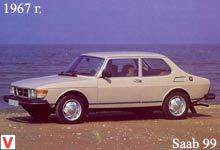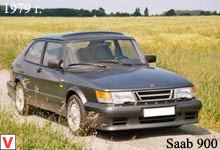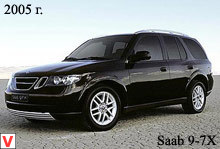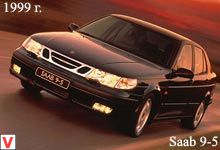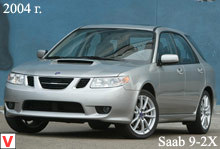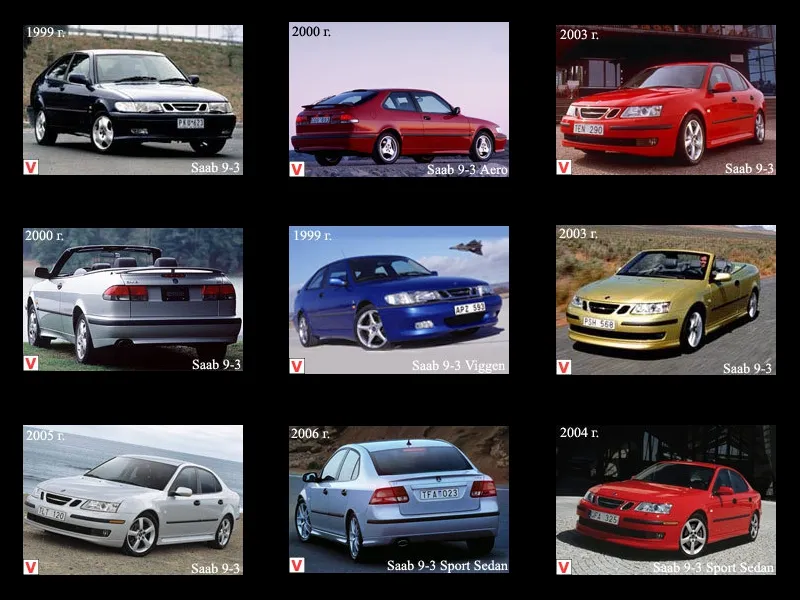
In early 1998, the Swedes presented an updated version of their 900th model. By analogy with the new flagship of the company - the Saab 9-5 sedan - the car was named 9-3. Outwardly, he was very similar to the ancestor of the 900th model, only the front part began to look more like a Saab 9-5. The largest update in the interior was the speedometer with a non-linear scale, the digitization of which was “stretched” to 140 km / h and “compressed” after. Scales of this kind are widely used in aircraft technology. The first generation Saab 9-3 has three body types. For the most practical offered 5-door hatchback.
To maintain the sporty image of the model - 3-door hatchback. For lovers to stand out from the city stream - a beautiful convertible. It was produced in Finland at the plant Valmet Automotive. There were five engines for them, and all four-cylinder engines. The most high-speed modification of the 9-3 series was named the 9-3 Viggen in honor of the company's first jet fighter. This model was equipped with a turbocharged 2.3 liter engine producing 225 hp. The car got reinforced, compared with the standard version, brakes and a more rigid sports suspension, which was developed in conjunction with specialists from the English company TWR. On the Saab 9-3 installed three types of transmission.
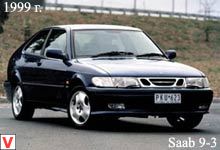
The most exotic and very rare was a mechanic with automatic clutch (this box is called Sensonic). Gears are switched there as in any manual gearbox - by moving the lever, but there is no clutch pedal at all! Sensonic appeared in 1995, but after several years of production of this transmission, Saab decided not to do it anymore - it turned out too expensive and was not in great demand. But the standard 5-speed manual and 4-speed automatic of the Japanese company Aisin have proven to be very reliable gearboxes.
The car is distinguished by a high degree of equipment: the basic version is already equipped with power steering, air conditioning, airbag, ABS and power accessories. Aerodynamic moldings kit is also included as standard. In addition, the Swedish cars have such an unusual twist as the night mode of the instrument panel lights, when the readings of the on-board computer, the air conditioner and everything else, except for the speedometer light, go out. It is noteworthy that the Saab 9-3 is one of the record for security in its class.
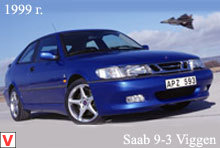
Along with the extensive zones of programmed deformation that exist in the front and rear parts of the body, the passenger compartment of the car is equipped with a very strong force structure with numerous stiffening ribs from floor to roof. In addition, active head restraints SAHR (Saab Active Head Restrains) and a complete set of airbags are responsible for providing passive safety. In the fall of 1999, the Saab 9-3 Aero appeared. This car took an intermediate position between the “just” 9-3 c 185 hp turbo engine. and a 225-strong viggen.
For many fans of powerful turbocharged engines, he became the first affordable car of this class, combining the prestige of the brand, outstanding power and reasonable price. A cramped cabin, an abundance of instruments - all this requires mastering and getting used to, which does not come immediately. There is even a boost pressure sensor, but in principle the on-board computer works without reading the instructions is not easy to understand - there are so many functions. By the number of buttons per square meter around the driver Saab 9-3 Aero is difficult to find equal.
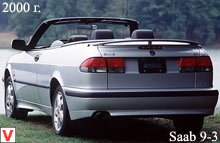
They are scattered everywhere: the management of mirrors is on the front door pillar, power windows are between the driver and the passenger, the trunk lock is in the center of the driver's door upholstery. Sport mode is activated with a button on the grip of the automatic transmission, and winter mode is the same, but located next to the gear selector. This is Saab's signature style, different from the usual. The two-liter engine brought to a power of 205 hp The power unit was installed on a standard chassis 9-3, which led to a marked decrease in controllability and directional stability at high speed.
In 2002, a completely new model, the 9-3, will debut. The appearance of the second generation marked a major change in the brand's policy. First, they abandoned the utilitarian hatchback in favor of the classic representative sedan. The name Saab 9-3 Sport Sedan was not chosen by chance.
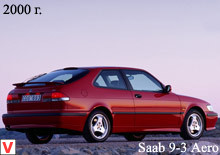
With this step, marketers of the company emphasized the nature and features of the model. The 9-3 also includes a station wagon and a convertible. The second-generation Saab 9-3 was built on the Epsilon platform, on which the Opel Vectra is based. In fairness, it is worth noting that many of the elements are specially refined and differently customized. In the rear suspension used new pliable elements designed to provide the effect of steering in corners. A steering mechanism of its own - "Saabovskoy" - development.
The car is equipped exclusively with turbo engines and new mechanical and automatic transmissions. A multi-link suspension, the ReAxs, appeared at the rear, and the steering mechanism was upgraded to increase its sensitivity and precision. The range of electronic active safety systems has been dramatically expanded: 9-3 received anti-lock and traction control systems, brake force distribution systems on the line and in corners, and the ESP stabilization system is also included in the options list.
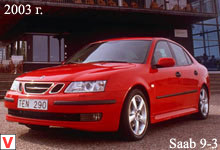
All these measures are designed to help the 9-3 model compete on equal terms with classmates of premium brands (primarily with the BMW 3-series and Mercedes-Benz C-class). It's great that with all the innovations this car is two hundred percent Saab. Decent vehicle with a stylish appearance and skillfully crafted interior. Thanks to the well-thought-out interior space and the latest technological developments, the salon turned out to be comfortable, cozy and perfectly equipped. Saab company in the style of the interior of their cars remains true to tradition, so the interior has not undergone significant changes for several decades.
The interior decoration is dominated by a strict color range, which is also characteristic of the entire model range of the company. For the decoration of the space are used as classic materials - for example, leather, and modern fabrics and plastics. For the design of the cabin Saab 9-3 second generation was used textured fabric with leather inserts. Leather inserts in the door panels are combined with leather-trimmed seats, steering wheel and gear lever. If desired, you can order seats, fully upholstered in leather. Compared with the previous model, the car interior has become more spacious. The driver's seat is very well equipped.
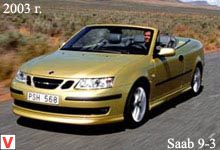
The steering column is adjustable in height and angle. The three-spoke steering wheel fits comfortably in your hand and completes the feeling of complete control over the car. Both at low and at high speeds, the steering response is excellent, and the sentronic control keys on it allow you to switch the transmission of the sequential, without taking your hand off the steering wheel. Also on the steering wheel handed audio control buttons, allowing not being distracted from the road if you want to increase the volume or switch the station. Under the right hand is a comfortable adjustable armrest, behind which an additional 12V socket is installed.
The ignition lock (which is quite usual, but only for SAAB) is placed on the tunnel between the front seats - just behind the gearshift lever. Car safety is at a very high level, as evidenced by the EuroNCAP tests, where SAAB 9-3 received five stars - the highest rating. Standard features include front passenger and driver airbags, side and top airbags, belt pretensioners, active front head restraints, and many other systems that provide safety in emergency situations. Well, the main advantage of the company Saab is the famous turbo engines, in the production of which for 25 years, Swedish engineers have reached a high level.
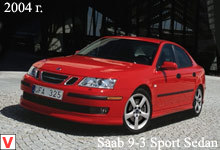
For the 9-3 Sport Sedan, the Swedes developed a new two-liter engine with an aluminum block and a cylinder head. There are three options for this unit. The most modest - 150-hp 2.0t engine. Further, in the lineup there is a 2.0T engine (unlike the previous one in the capital "T"), 175 hp already develops. Saab 9-3, as before, remained a front wheel drive car. Engines are paired with a five or six-speed manual transmission. And for a fee, you can get a five-speed automatic “Saab Sentronic”, with the shift function on the steering wheel. The car is available in three trim levels: "Linear", "Arc" and "Vector".
For production cars there are two types of suspension - standard and sport, which is installed only on the Saab 9-3 Aero. Structurally, the suspension is the same, but for Aero, the suspension is “sharpened” in a different way - in a sporting way. The first time the second-generation Saab 9-3 was produced only in a sedan, but in 2003 a convertible (Convertible) appeared. Despite the obvious external resemblance to the Sport Sedan, the version with a folding roof was made not on the basis of a sedan, but separate from it. models was conducted in parallel. It is known that such a body structure reduces its rigidity, and this adversely affects handling and comfort.
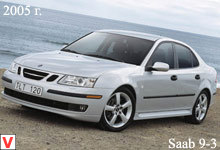
The Swedes have improved the torsional stiffness index three times compared with the previous model! This was achieved due to the fact that the front and rear parts of the car, as well as the side power elements are combined with a kind of stiffening ring, which largely compensates for the lack of a roof, positively affecting driving performance and passive safety. Convertible traditionally for all modern Saab offers the maximum level of protection. It is implemented as follows. In the front seats integrated frames on which seat belts are mounted. The front airbags are adaptive, their impact resistance depends on the impact force.
The side cushions protect the head and torso of those sitting in the car and also have two steps of operation. The list of electronic devices includes the “active” head restraints SAHR (Saab Active Head Restraints), which protect the neck and spine of the passenger from injury when they are hit from behind. If it comes to a coup, then several protection components come into play (DynaCage system): the seat belt pretensioners are activated and the safety arcs are fired from behind. A powerful body structure with reinforced front struts and a calculated deformation algorithm leaves a large supply of space to those sitting in the car during an accident.
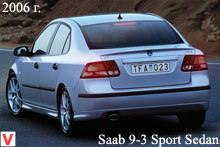
According to the ideology of the Saab 9-3 family, excellent handling is one of the main advantages of this model. The suspension is exactly like the 9-3 Sport Sedan. Its settings should please the active driver. Engines are also familiar to us from the sedan. These are two-liter sixteen-valve units equipped with a turbocharger.
Power - 175 or 210 hp A choice of three gearboxes: two manual (six steps for powerful versions and five for the weaker) and a new automatic with manual sequential shifting Saab Sentronic. The peculiarity of this box is that it adapts to the driving style of the driver and the driving conditions. The roof is another masterpiece of design ideas. It automatically folds in twenty seconds.
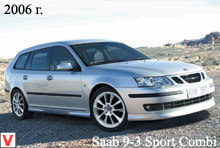
Moreover, in the "combat position" is released a decent place in the trunk. The roof of the cabriolet is mounted on six brackets (there were five on the past). Improved vibration and noise insulation. The coefficient of drag Cx is very decent for a convertible of 0.34. The model is positioned by its creators as a means of transportation for those who do not like compromises and are used to being guided in life not only by considerations of rationality, but also by emotions. Like the very first Saab 9-3 convertible, the new car is focused primarily on the American market.
Collect it at the factory Magna Steyr Fahrzeugtechnik in Austria. Since autumn 2005, sales of upgraded versions of the Saab 9-3 with an updated engine lineup began in Europe. Since 2006, the range of engines of the model year is opened by a 1.8 liter naturally aspirated engine with a capacity of 122 hp, followed by a 2.0 liter turbo version with 150 hp and 175 hp.
or 210 hp (Aero version). Crowned with a line of power units are new Holden turbo engines of 2.8-liter, turbo-charged, with an output of either 230 hp or 250 hp. In addition, for some markets, 1.9-liter turbo diesel engines are offered, developing in an 8-valve version 120 hp and in a 16-valve - 150 hp Turbodiesel meets the environmental standards Euro 4, equipped with a new anti-soot self-cleaning filter that significantly reduces CO2 emissions. KP choice - 5 or 6-step "mechanics" or 5 or 6-step "automatic". Monumentality of the center console, instrument cluster and the overall style of the cabin are made in the tradition of the brand Saab.
The steering wheel covered with soft leather has a familiar set of keys: audio system, mobile phone control, cruise control. In addition, there is a new button that controls the AVR system, which allows the driver to give voice commands, controlling the navigation system, built-in phone, CD player and radio. Also, the Saab 9-3 Sport sedan uses the ComSens system, which cuts off emergency warnings or incoming calls to the built-in mobile phone at the moments when the driver drives the car in extreme conditions. At the end of the "dangerous modes" indicators on the panel are lit and incoming calls begin to be received.
Outside, this is the same Saab 9-3. Body-colored bumpers and sills give the car a more aggressive look. 17-inch wheels and a spoiler on the trunk lid leave no doubt in sports ambitions. Since the summer of 2005, sales of the Saab 9-3 Sport Combi, a sports wagon based on the 9-3 Sport Sedan, began in Europe. For the sake of dynamic styling, the designers refused to increase the length of the body, as a result, the luggage compartment volume is from 419 to 1273 liters. Gamma engines and configuration similar to the sedan. The next Saab 9-3 update will get in the middle of 2007, taking individual features from the Aero X concept.
